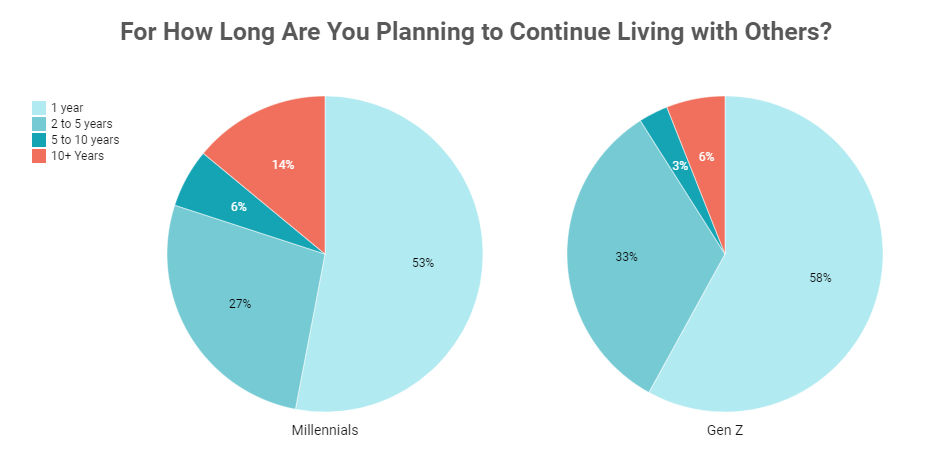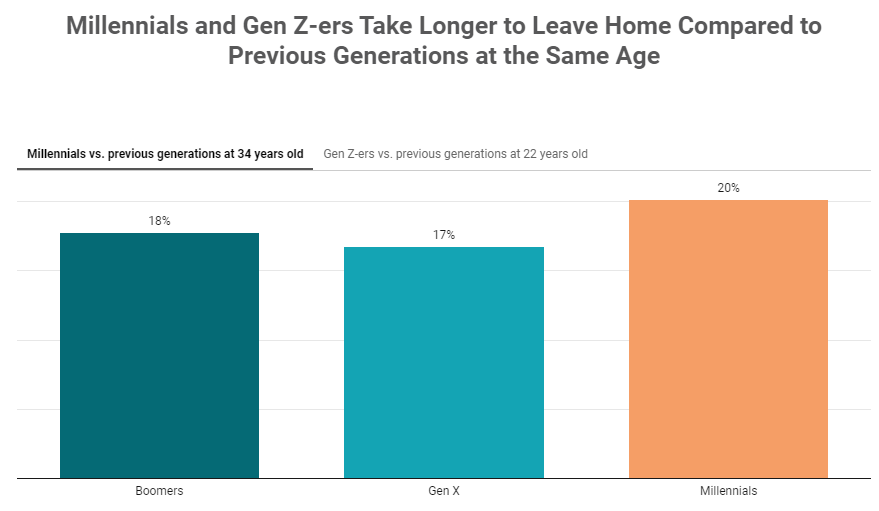A whopping 68% of young Gen Z adults are choosing to live with family as opposed to independent living, according to a new RentCafe report. While living with relatives may offer a bit of financial relief for would-be homebuyers, Millennials aren’t far behind, with 20% still residing in their parental homes.
The report reveals what the increasing trend of multigenerational homes means for society, the economy, and the generations included. New data revealed the financial and evolving family structures that are now reshaping the American Dream for potential U.S. homebuyers across the nation.
The most recent RentCafe analysis of IPUMS data showed that approximately 14 million millennials and an astounding 23 million Gen Zers shared a household with at least one family member, representing the largest generational shares across all age groups. Of the 51 million people living in multigenerational households today, some eight million are Gen X and six million are baby boomers.

Top 10 Metros with Largest Share of Millennials Living in Multigenerational Households:
- Los Angeles (35%)
- Riverside, CA (35%)
- New York (28%)
- Baltimore (27%)
- Buffalo, NY (26%)
- Miami (25%)
- Washington, D.C (25%)
- Sacramento, CA (25%)
- San Jose, CA (25%)
- Detroit (24%)
Top 10 Metros with Largest Share of Gen Zers Living in Multigenerational Households:
- Raleigh, NC (87%)
- Riverside, CA (85%)
- Providence, RI (84%)
- Washington, D.C (81%)
- Los Angeles (80%)
- Pittsburgh (80%)
- Philadelphia (79%)
- New York (79%)
- Boston (78%)
- Charlotte, NC (76%)
Millennials and Gen Zers living at home don't see things changing any time soon, either, according to RentCafe's latest survey. More than 40% of Millennials (47%) and Gen Zers (41%) expect to continue sharing their home with a family member or someone else for at least another two years. However, approximately 14% of Millennials expect to live in a shared household for at least a decade, while Gen Zers remain more optimistic, with only 6% envisioning the same living arrangement into adulthood.
To come to a better understanding of this generational trend, RentCafe analyzed IPUMS data and looked at the 50 largest metros in the U.S. by population to determine the multigenerational hotspots for younger generations, as well as which Millennials and Gen Zers are finding it harder to leave the nest compared to their peers.

The study found that millennials and Gen Zers working a service job are more likely to continue living in a multigenerational home.
While the reasons many adults stay with their parents in today's economy vary, it boils down to either financial- or health-related circumstances. According to RentCafe data, the typical millennial living with a family member at the age of 32 shares their home with three or four other people. They're also likely to be employed in food services, construction, or education.
Overall, Millennials are slower when it comes to leaving the nest compared to previous generations, with roughly 18% of baby boomers and 17% of Gen X living with their parents at the same age as today's average millennials. Likewise, Zoomers also struggle: By 22 years old, an estimated 66% of millennials, 65% of Gen X, and 61% of boomers were still at home, surpassed by a 68% share of Gen Z.
This difference between generations could be explained by various factors. For instance, younger generations may find it more appealing to continue living in their parents homes in order to save money on expenses such as childcare costs, utility bills, rent, or a future down payment. On the other hand, it’s also likely that more and more millennials and Zoomers might choose to remain home to care for family members.
The survey found that the Golden State of California is the most popular state for multigenerational living.
When it comes to the largest shares of multigenerational households, West Coast metros dominate. Out of approximately 3 million millennials in Los Angeles, 35% live with family members. For Zoomers, it's 81% out of roughly 1.3 million. Here, the high cost of living in the metro area—which is 51% above the national average—explains why many young adults are finding it difficult to leave this living arrangement.
Interestingly, Raleigh, NC, is the #1 hotspot for Zoomers in multigenerational households. In 2022, 87% of the 178,000 Zoomers in Raleigh still lived with family members.
Back on the West Coast, California's Riverside metro area takes second place for both generations. Approximately 35% of nearly 1 million Millennials and 85% of around 460,000 Zoomers have yet to leave the nest. The third spot is shared by the metro areas of New York and Providence, RI. Millennials claim the Big Apple, with 28% living in multigenerational households, while the Renaissance City leans more toward Zoomers.
Two other East Coast metro areas—Baltimore and Washington, D.C.—are also popular among millennials and Zoomers. In Baltimore, 27% of Gen Y and, in D.C., 81% of Gen Z live with family members. And, despite the availability of housing options in both places, the cost of living remains a significant factor. Baltimore's cost of living is 8% above the national average, while Washington, D.C., soars to 52% above.
Millennials in Buffalo, NY, face even greater challenges: With a 26% share out of approximately 205,000 peers belonging to this generation, Buffalo is one of the few metros that has seen an increase of 6% since five years ago. Although the cost of living is lower than the national average, the lack of new housing in the city contributes to millennials' delayed flight from the nest.

What are the metro areas where millennials and Zoomers have the easiest time leaving the parental home?
Contrary to the belief that the pandemic has increased the number of adults living with their parents, the data we collected shows a different reality. More precisely, in more than 20 of the largest U.S. metros, the number of Gen Yers and Gen Zers living in multigenerational households has been decreasing over the past five years, with many of them beginning to move out on their own. Notably, one of the most significant declines is observed in the Cincinnati area, with 67% fewer millennials and 60% fewer Zoomers living with family members compared to 2018.
In the case of Gen Z, it's Milwaukee that takes the crown when it comes to young adults leaving their parental homes—62% fewer Zoomers live in multigenerational households now than they did five years ago. Similarly, the share of millennials in multigenerational households in Nashville, TN, during the last five years has decreased by 65%.
The situation is just as rosy for those in the Raleigh area, with a decrease of 62% in the number of millennials in multigenerational homes since five years ago. And, although Raleigh may not be the ideal spot for Zoomers to strike out on their own, Virginia Beach, VA, provides that opportunity. The share of Gen Zers in multigenerational households here has decreased by nearly half (48%) in the last five years. Not to be outdone, Memphis, TN, and Las Vegas, are two other metros where the shares of millennials and Zoomers living with family members significantly decreased. Compared to 2018, Memphis experienced a 58% decrease for millennials, and Las Vegas had a 47% decrease for Zoomers.
Rounding out the top five lists of areas where younger generations finally set out on their own are St. Louis and Jacksonville, FL.
Adults living in multigenerational households are on the rise in three particular metro areas.
Leaving the parental nest is a complex issue that's influenced by factors such as employment, cost of living, and personal preference. However, while the trend is moving toward a decrease in multigenerational living, certain metro areas and demographics contradict this trend. Richmond, VA, has witnessed a 15% increase in the number of millennials living in multigenerational households and a 2% increase for Gen Zers compared to five years ago. In the same vein, Louisville, KY, has also experienced a similar increase, with a 21% rise for millennials and a 24% rise for Zoomers. This leads to shares of 15% and 73%, respectively.
The ever-popular Buffalo, NY, has seen more modest increases, with a 6% rise for millennials and a 2% rise for Gen Zers in multigenerational living, while Denver experienced an increase (9%) in the number of Zoomers living with relatives.
To read the full report, including more data, charts, and methodology, click here.

 theMReport.com Your trusted source for mortgage banking news
theMReport.com Your trusted source for mortgage banking news








